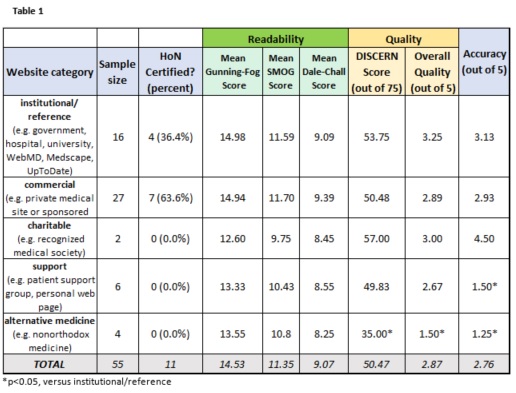Back to 2017 Program
Separating the wheat from the chaff: an evaluation of readability, quality, and accuracy of online health information for treatment of Peyronie’s disease
Theodore Cisu, BS, Nicholas J. Bompastore, BA, Peter Holoch, MD.
University of Vermont College of Medicine, Burlington, VT, USA.
BACKGROUND: Peyronie’s disease affects 3.2-8.9% of the adult male population. In the digital age, it has become commonplace for patients to self-diagnose and explore treatment options online. In the realm of Peyronie’s disease specifically, there is significant variability in the quality of information on the web. This study characterizes available information about Peyronie’s disease online and evaluates its readability, quality, and accuracy using a set of validated instruments and expert opinion.
METHODS: The search term “Peyronie’s disease” was queried on three major search engines (Google, Bing, Yahoo) and the first 50 search results on each search engine were assessed. Paid advertisements, duplicated websites, news articles, review articles, medical dictionaries, videos, and sub-pages of similar parent websites were excluded. All websites were categorized as institutional/reference, commercial, charitable, support, or alternative medicine (Table 1). The first 30 sentences on each website discussing treatment options were analyzed for readability using a three-pronged set of validated algorithms: the Gunning-Fog score, SMOG index, and Dale-Chall readability formula. The quality of each website was assessed with the validated Oxford DISCERN instrument by two trained readers whose scores were then averaged. Each website was also cross-referenced with the Health on the Net Foundation (HoN). Each 30-sentence block was assessed for accuracy by a fellowship-trained urologist on a 1-5 scale, where 1 and 5 correspond with 0% and 100% of the information in the text is accurate, respectively.
RESULTS: Of 150 websites assessed across the three major search engines, 55 websites met inclusionary criteria. The mean readability scores across all websites were 14.53 (Gunning-Fog), 11.35 (SMOG), and 9.07 (Dale-Chall), which correspond to an 11th-12th grade reading level. Readability levels were not statistically different between website categories (Table 1). However, the quality of health information on institutional websites (53.75) was significantly higher than alternative medicine websites (35, p=0.016) and trending higher than commercial (50.48) and support (49.83) websites. Further, 20% of the websites were HoN code-certified, comprised entirely of commercial (63.6%) and institutional (36.4%) websites. Similarly, accuracy of websites varied according to website category. Institutional and charitable websites had highest accuracy scores (3.13 and 4.50, respectively) whereas support (1.50) and alternative medicine websites (1.25) had the lowest accuracy scores (p=0.007 and p=0.008, respectively).
CONCLUSIONS:
Most health information online regarding treatment of Peyronie’s disease is on non-institutional “dotcom” websites not certified by the Health on the Net Foundation, the gold standard for online health information. Despite the fact that most of the information from academic and charitable websites is of adequate quality and accuracy, the readability of websites exceeds the reading ability of most U.S. adults by several grade levels. Urologists should assist patients in navigating digital resources to find accurate, high-quality websites that are written at the recommended 7th-9th grade reading level and work to improve health information online for Peyronie’s disease and its treatment.

Back to 2017 Program
|
|
|
|




